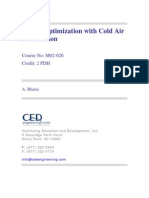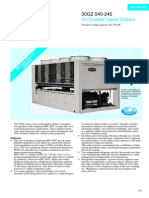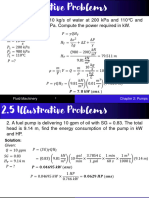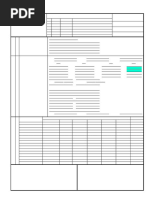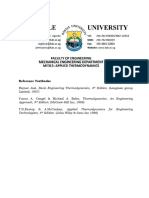Ventilación
Ventilación
Uploaded by
Angel AlvarezCopyright:
Available Formats
Ventilación
Ventilación
Uploaded by
Angel AlvarezOriginal Description:
Original Title
Copyright
Available Formats
Share this document
Did you find this document useful?
Is this content inappropriate?
Copyright:
Available Formats
Ventilación
Ventilación
Uploaded by
Angel AlvarezCopyright:
Available Formats
52nd North Carolina Industrial
Ventilation Conference
Basics of Ventilation II
Prerequisite Knowledge
Review of Phase I
In Advanced Design or I&M, the attendee
should already be familiar with basic air
properties such as:
North Carolina Industrial Ventilation
C f
Conference
Raleigh, North Carolina
April 2009
Density
Specific volume
Density factors for
BA--1-2
BA
BA--1-2
BA
Prerequisite Knowledge
Prerequisite Knowledge
and know basic hood nomenclature
terminology and application:
Temperature
Elevation
Moisture
Pressure
and Know what types of hoods are used in industrial
ventilation:
Volumetric flow rate
Velocity (minimum duct design, capture, face,
plenum, duct, and minimum transport)
Velocity pressure (duct and slot)
Hood static pressure
Simple hoods
Compound/slotted hoods
Enclosing hoods
Exterior (capture) hoods
Canopy hoods
Push-pull hoods
and understand the effects of slotted hoods, baffles,
and flanges.
BA--1-2
BA
BA--1-2
BA
Density (
()
Properties of Air
Identify important properties of air.
BA-1-2
Density and specific volume
Density factor at various air conditions.
Mass flow rate
ACFM (i.e., actual volumetric flow rate).
Types of pressures in a ventilation system.
BA--1-2
BA
Defined as mass/volume
Units of measure:
lbm/ft3
grams/cm3 (metric)
grains/ft3
BA--1-2
BA
52nd North Carolina Industrial
Ventilation Conference
Properties of Air
Specific Volume (SV)
Sea Level Density
1 ft
= 0.075 lbm/ft3
0.075
0 075 lbm
1 ft
STANDARD
CONDITIONS
Defined as
volume/mass
Units of measure:
ft3/lbm
1 ft
ft3
1
of air weighs 0.075 lbm @ 70 F, no moisture
Or, 1 Standard Cubic Foot (SCF) weighs 0.075 lbm
BA--1-2
BA
BA--1-2
BA
Sea Level Specific Volume
SV = (1/density) or (1/
(1/)
Problem 1
2.38 ft
13.35
cubic feet
2.38 ft
SV =
= 1 / 0.075 ft3/lbm
13.35 ft3/lbm
2.38 ft
A pound of air will occupy 13.35 cubic feet at sea level,
with no moisture, and 70 F (i.e., standards conditions).
BA--1-2
BA
5,500 cubic feet of air flows through a duct
every minute at Standard Conditions. How
manyy p
pounds per
p minute?
lbm 5500 ft 3 0.075lbm
min min
ft 3
Standard Conditions (STP with no moisture):
Temperature, and/or
Pressure (elevation), and/or
Humidity (i.e., an increase in RH)
Where:
11
Temperature = 70 F, and
Pressure = 14.7 psia, and
Moisture = 0 RH.
Actual conditions are caused by changes in:
Actual Conditions
BA-1-2
10
Actual Conditions
A pound of air with a
different temperature
than 70 F, or at a
diff
different
t elevation,
l
ti
or
with moisture mixed in
will have some other
specific volume and
density.
BA--1-2
BA
412.5 lbm/minute
BA--1-2
BA
Specific Volume
Anywhere Else
? cubic
feet
STP = standard temperature and pressure with no moisture
psia = pounds per square inch atmospheric
RH = relative humidity (i.e., moisture content)
BA--1-2
BA
12
52nd North Carolina Industrial
Ventilation Conference
Actual Conditions
Problem 2
Any condition where the air is not at Sea
Level, 70 F, and carries no moisture.
It is significant in our work if:
Temperature > 100 F
Elevation > 1000 ASL
Dew Point > 80 F
Industrial Ventilation Design Manual, page 3-14
BA--1-2
BA
7,500 actual cubic feet of air flows through
a duct every minute at a density of 0.043
lbm/ft
/ 3. What is the mass flow rate in lbm
per minute?
lbm 7500 ft 3 0.043lbm
min min
ft 3
13
BA--1-2
BA
The Perfect Gas Law
Combines Boyles Law, Charles Law, and GayLussacs Law into a single Equation.
Equation used in this course: P = Rg T
The pressure the gas sees (i.e., absolute Pressure).
The temperature
p
of the gas
g (i.e.,
( , absolute
Temperature).
The presence of moisture or any other material mixed
with the gas.
Ru
M
Ru = Universal Gas Constant = 1545.4 ft-lbf/lbm R
M=
Molecular Weight of the gas
IV Design Manual, Appendix B, page 14-23
15
BA--1-2
BA
16
Density Factor (df)
Density of Standard Air
Rg is the Gas Constant unique for a particular gas:
PV=nRT
BA--1-2
BA
14
P = Rg T
Knowing the mass a gas, then the density and
the volume it occupies will be a function of:
322.5 lbm/minute
IV Design Manual, page 3
3--14
MAIR = 28.96 lbm/mole
Pressure at Sea Level = 14.7 psi
TSTD 70 F = (460 + 70) R = 530 R
Ru = 1545.4 ft-lbf/mole-R
Rg = 53.36
Defined as the
ratio of actual
density to
standard density
P = RT = P/RT
in 2
(14.7)(144 2 )
lbm
P
ft
0.075 3
ft
( Rg )(T ) (53.36)(530)
df act
std
act
0.075 lbm
ft 3
BA--1-2
BA
BA-1-2
17
BA--1-2
BA
18
52nd North Carolina Industrial
Ventilation Conference
Density Factor
Components
Problem 3
Density Factor
Temperature: dfT = Tstd/Tact = std/act
Elevation: dfe = [1 (6.73 10-6)(z)]5.258
Moisture: dfm = p
psychrometric
y
charts ((dfT & dfm)
Pressure: dfp = [(407 + SPduct)/407]
Air enters a fan at 280 F and -28 wg pressure.
The Fan is located at 3200 ASL. What is the
Density Factor of the Air at the fan inlet?
Density Factor ((df
df)) = dfT dfe dfm dfp
dfT = 530/(460 + 280) = 0.72
dfe = [1 (6.73 10-6)(3200)]5.258 = 0.89
dfm = 1 (no moisture)
dfp = [(407 - 28)/407] = 0.93
df = dfT dfe dfm dfp = 0.60
BA--1-2
BA
19
BA--1-2
BA
20
Relationship between Mass
Flow Rate and CFM
m air
3
lbm ft lbm
3 Q ( )
min min ft
m total
m total m air 1
H 2O
m total m air 1
Flow Rate (CFM)
Qact(act)=Qstd(std)(1+)
lbm ft lbm
3 Q ( )
min min ft
Qact [(act)/(std)]= Qstd (1+)
m total (Qact )( act ) (Qact )( act )(1 )
Qact = Qstd (1+) (1 / df )
BA--1-2
BA
21
BA--1-2
BA
Actual Volumetric Flow
Rate (Qact)
m air
m H 2O
Why ACFM?
m total
1
Qact Qstd
df act
Actual CFM ACFM
22
m H 2O
m air
Used to size the Air
Control Device
correctly
Used to size the
duct correctly
Used to size the
Fan correctly
Density Factor
Standard CFM SCFM
BA--1-2
BA
BA-1-2
23
BA--1-2
BA
24
52nd North Carolina Industrial
Ventilation Conference
Three Pressures at any
Point in a Duct System
Problem 4
ACFM
m std (Qstd )( std )
4,100 lbm of air at
standard conditions
enters a dryer where it
picks up 320
lbm/minute of water
and leaves with a
density factor of 0.72:
Qstd = 4,100 lbm 0.075 lbm/ft3
= 54,667 scfm
ACFM (SCFM )
1
df
1
320
1
0.72 4100
ACFM (54,667)
What is the Air Volume
(Qact)?
ACFM 81,852 ACFM
SP
SP
SP
SP
SP
VP
Comparison to Atmospheric
(+/--)
(+/
+
Less Than
Atmospheric
(or velocity velocity pressure)
VP df (V / 4005)
VP
V 4005
df
(-)
VP:
27
System Components
BA-1-2
V = velocity in fpm
VP = Velocity Pressure in "wg
df = density factor
BA--1-2
BA
28
Static Pressure Losses
(hood)
(Fh)(VPd)
(compound hood)
[(Fs)(VPs)]
(acceleration)
1VP
(duct friction)
(Fd)(VPd)
(elbows)
(Fel)(VPd)
(entries)
(Fen)(VPd)
(Fspecial fittings)(VPd)
+
Other Losses
Static Pressure
Hoods
Ducts
Air pollution control equipment
Fans
Exhaust stack
BA--1-2
BA
Equals (TP SP)
Cannot be measured directly
Represents kinetic energy
Where:
BA--1-2
BA
26
Velocity Pressure Velocity
Greater Than
Atmospheric
Total Pressure
BA--1-2
BA
(+)
SP
SP
VP
Velocity Pressure
25
SP
SP
TP
SP
Static Pressure
@ df = 0.72
BA--1-2
BA
SP
SP
Other Losses = air pollution control device,
loss from velocity increase, etc.)
29
BA--1-2
BA
30
52nd North Carolina Industrial
Ventilation Conference
Design of Local Exhaust
Hoods
When we can predict the location of a release of dust or
other contaminant, we can pull a small amount of air
immediately next to the source to remove the
contaminant effectively.
Poor hood design can lead to:
Hood Types
POOR contaminant control,
BIG air pollution control equipment costs ($$$),
BIG replacement air costs ($$$), and
BIG fans with BIG motors ($$$).
ACGIH, Industrial Ventilation A
Manual of Recommended Practice
for Design, 26th Edition
The challenge it to remove the smallest amount of air
with the greatest concentration of pollutant!
BA--1-2
BA
31
BA--1-2
BA
Hood Refresher
Hood Static Pressure
Q = VA
Capture velocity
Minimum transport velocity
Acceleration loss (not really acceleration
it is energy transfer)
Flanges and affects on airflow
Air Volume Requirements
BA--1-2
BA
33
BA--1-2
BA
34
Given a flanged slotted hood for a welding operation
in an area with disturbing air currents, where:
(Fi
(Figure
1.1)
1 1)
= 4005 (0.78/0.89)0.5 = 3,748 fpm
V = 4005
A = 0.1963 ft2 (from IV Design Manual, page 9-38)
Qact = VA = 3,748 0.1963 = 736 ACFM
Qact = Qstd (1/df) (1 + )
736 = Qstd (1/0.89) (1) 655 SCFM
(VP/df)0.5
BA-1-2
he = (Fh)(VPd), or
he = (Fs)(VPs) + (Fh)(VPd), for compound hoods
Fh = hood entry loss coefficient
Fs = slot loss coefficient
VPd = duct velocity pressure in wg
VPs = slot velocity pressure in wg
Problem 6
Find Qact, where:
BA--1-2
BA
SPH = he + VP
Where:
Problem 5
VP = 0.78 wg
df = 0.89 (no moisture i.e., = 0)
D = 6 inches
Qactt = ________
32
35
df = 0.76 (no moisture i.e., = 0) and 90 included angle
Aslot = 2.41 ft2 and Xsource = 1.5 ft and Dduct = 16
= ________ fpm
Vcapture
p
Qact = ________ ACFM
SPhood = ________ wg
(Figure 6.11)
Vcapture = 200 fpm (from IV Design Manual, page 6-8)
Q = 0.75V(10X2 + A) = (0.75)(200)[(10(1.5)2 + 2.41)] = 3,736 SCFM
Qact = Q (1/df) (1 + w) = (3,736/0.76) (1) = 4,916 ACFM
VPslot = 0.20 wg
and
VPduct = 0.59 wg
Fslot = 1.78
and
Fhood = 0.25
SPhood = 1.78(0.20) + 0.25(0.59) + 0.59 = 1.09 wg
BA--1-2
BA
36
52nd North Carolina Industrial
Ventilation Conference
System Component
Losses
(hood)
(Fh)(
Fh)(VPd
VPd))
(compound hood)
[(Fs)(VPs)]
(acceleration)
1VP
(duct friction)
(Fd
Fd)(
)(VPd
VPd))
(elbows)
(Fel)(
Fel)(VPd
VPd))
(entries)
(Fen)(
(Fen)(VPd
VPd))
(Special fittings)(VPd
fittings)(VPd))
+
Other Losses
P - Static Pressure
Fen is a function of:
Angle of Entry
Looking for efficiency
(lowest Fen)
Recommended angle < 45
30 and 45 are most
Least Efficient (90)
39
Contractions and
Expansions
Fd =
(0.0307)(V)0.533
(Q)0.612
BA--1-2
BA
40
Problem 7
Calculate the static pressure losses through the system and
properly size the orifice (at standard conditions).
Fitting ducts into tight places
Fit equipment
Provide high discharge velocity at end of stack
Contractions increase the duct velocity erosion
considerations in particulate conveying systems
Expansions decrease the duct velocity minimum
transport considerations in particulate conveying systems
Energy loss or regain a function of geometry of the
transition piece
BA--1-2
BA
BA-1-2
Length of duct
Diameter of duct
(smaller diameter has
more friction)
Speed of air through
the duct
Contractions and Expansions
Use for:
38
SP =FductVP=
(Fd)(L)VP
Losses are a function
of:
Straight Duct
Most Efficient (<10)
BA--1-2
BA
common
30
30
R/D
Number of pieces
Degree of turn (e.g., 45, 90)
37
BA--1-2
BA
90
90
3
90 called elbows
< 90 called angles (e.g.,
30, 45, 60)
Recommended R/D?
Branch Entries
Fel is a function of:
BA--1-2
BA
Elbows
41
BA--1-2
BA
42
52nd North Carolina Industrial
Ventilation Conference
Problem 7
Problem 7
Contractions and Expansions
Contractions and Expansions
Losses for Segment 1-A:
Losses for Contraction (Figure 9-d):
V = Q/A1-A = 9,500 cfm/2.6398 ft2 = 3,599 fpm
VPd = df(V/4005)2 = (1)(3,599/4,005)2 = 0.81 wg
SPh = FhVPd + 1VPd = VPd(1 + Fh)
= 0.81(1 + 0.49) = 1.20 wg
Fd = 0.0307(V0.533/Q0.612)
(or use Table 9-4)
= 0.0307(3,5990.533/95000.612) = 0.0089
SPDuct Friction = (Fd)(L)(VPd) = 0.0089(100)(0.81) = 0.72 wg
SP1-A = (SPh + SPDuct Friction) = (1.2 + 0.72) = -1.92 wg
SP2
SP1
VP1
V2
VP2
L
SP2
BA--1-2
BA
=
=
=
=
=
=
=
=
SP1 - (VP2 - VP1) - L(VP2 - VP1), where
-1.92 wg
0.81 wg
Q/AA-B = 9,500 cfm/1.7671 ft2 = 5,376 fpm
df(V2/4005)2 = 1(5,376/4,005)2 = 1.80 wg
0.08 (for 15 degree taper angle)
-1.92 - (1.80 0.81) 0.08(1.80 0.81)
-2.99 wg (SP at exit from contraction)
43
BA--1-2
BA
Problem 7
Problem 7
Contractions and Expansions
Contractions and Expansions
Losses for Segment 1-B:
Regain for Expansion (Figure 9-d):
SPContraction Exit = -2.37 wg
VA-B = 5,376 fpm
VPA-B = 1.80 wg
Fd = 0.0307(V0.533/Q0.612)
(or use Table 9-4)
= 0.0307(5,3760.533/95000.612) = 0.0110
SPDuct Friction = (Fd)(L)(VPd) = 0.0110(10)(1.80) = 0.20 wg
SP1-B = (SPDuct Friction + SPContraction Exit)
= (0.20 + 2.99) = -3.19 wg
SP2
SP1
VP1
V2
VP2
R
SP2
BA--1-2
BA
=
=
=
=
=
=
=
=
SP1 + R(VP1 - VP2), where
-3.19 wg
1.80 wg
3,599 fpm
0.81 wg
0.83 (15 degree taper angle; D2/D1 = 1.22)
-3.19 + 0.83(1.80 0.81) = -3.19 + 0.82
-2.37 wg (SP at exit from expansion)
45
BA--1-2
BA
Problem 7
46
Problem 7
Contractions and Expansions
Contractions and Expansions
Losses for Segment 1-C:
Orifice Design:
SPExpansion Exit = -2.37 wg
VB-C = 3,599 fpm
VPB-C
0 81 wg
wg
B C = 0.81
Fd = 0.0089
SPDuct Friction = (Fd)(L)(VPd) = 0.0089(40)(0.81) = 0.29 wg
SP1-C = (SPDuct Friction + SPExpansion Exit)
= (0.29 + 2.37) = -2.66 wg
BA--1-2
BA
BA-1-2
44
47
(SPh + SPDuct Friction) = -2.66 wg
V = Q2-C//A2-C = 3,000
,
cfm/1.3963
/
ft2 = 2,149
,
fpm
p
VP = df(V/4005)2 = 1(2,149/4,005)2 = 0.29 wg
(or use Table 9-4)
Fd = 0.0307(V0.533/Q0.612)
= 0.0307(2,1490.533/95000.612) = 0.0137
SPDuct Friction = (Fd)(L)(VPd) = 0.0137(20)(0.29) = 0.08 wg
SPh = 2.66 - SPDuct Friction = 2.66 0.08 = -2.58 wg
BA--1-2
BA
48
52nd North Carolina Industrial
Ventilation Conference
Using the Calculation
Sheet
Problem 7
Contractions and Expansions
Orifice Design:
SPh = 2.66 - SPDuct Friction = 2.66 0.08 = -2.58 wg
SPh = FhVPorifice + 1VPd
= 1.78(VPorifice) + 1(0.29)
VPorifice = (2.58 0.29)/1.78 = 1.29 wg
Vorifice = 4005(VP/df)0.5 = 4005(1.29/1)0.5 = 4549 fpm
Aorifice = Qorifice/Vorifice = 3,000 cfm/4549 fpm = 0.6595 ft2
Dorifice = (4 144 Aorifice/)0.5 = (4 144 0.6595/ )0.5
= 11 inches
BA--1-2
BA
49
ACGIH Calculation Sheet
BA--1-2
BA
51
BA-1-2
BA--1-2
BA
50
Calc Sheet Q, V, D, and VP
BA--1-2
BA
52
Calc Sheet Duct, Elbow,
Entry Losses
Calc Sheet Hoods
BA--1-2
BA
Using the results from Problem 7, input the
data for segment 1-A into a calculation
sheet.
53
BA--1-2
BA
54
52nd North Carolina Industrial
Ventilation Conference
Calc Sheet Other Losses;
SP; Corrected Q, V, and VP
Balancing Methods
With blast gates
Advantages
Di d
Disadvantages
t
Not tamper-proof
Higher initial cost
Balance-by-design
Advantages
Disadvantages
BA--1-2
BA
Adjustable
Design flexibility
No tampering
No blast gates to wear
Higher airflows
55
BA--1-2
BA
56
Accounting For Acceleration at
Branch Entries
Balancing Branch SP at Entries
Weighted Average VP
Q1 + Q2 = Q3
SP1 = SP2 = SP3
Adjustments:
corr
Pressure
2
No adjustment (SPdiff < 5%)
Calculate Qcorr , Vcorr, and VPcorr for branch with lower SP (5% <
SPdiff < 20%)
Redesign branch with lower SP (SPdiff > 20%)
design
SP
SP
VPr = (VP1)(Q1/Q3) + (VP2)(Q2/Q3)
Used to be called Resultant Velocity
Now more correctly named:
Now,
Weighted Average Velocity Pressure
gov
duct
BA--1-2
BA
57
BA--1-2
BA
Accounting For Acceleration at
Branch Entries
Exhaust Stacks
Weighted Average VP
VPr = (VP1)(Q1/Q3) + (VP2)(Q2/Q3)
Accounting for acceleration:
58
Do not use weather caps!
If (SP3 - VPr) > 0, account for acceleration (insert difference
on line 40 of calc sheet)
If (SP3 - VPr) < 0, no acceleration or a deceleration occurred
and the difference is unaccounted for in the system design
N l
No-loss
stacks
k
Losses associated with them
May also have other system
effects
Stack diameter = D + 1
Stack height = 4D + 6
D = duct diameter
Maintain discharge velocity
of > 3,000 fpm
Weather Cap
D
No--Loss Stack
No
BA--1-2
BA
BA-1-2
59
BA--1-2
BA
60
10
52nd North Carolina Industrial
Ventilation Conference
Stack Height Above a
Building
System Static Pressure
BA--1-2
BA
The amount of pressure required by the
fan to overcome the resistance in the
system
Determined by data from the calculation
sheet
System SP = SPout - SPin - VPin
Basis for selection of the Fan Static
Pressure (FSP)
61
BA--1-2
BA
Summary
Objectives 2
Goal: The attendee will identify the important
concepts from Phase 1 important in industrial
ventilation system design.
Identify important properties of air
air.
Apply and perform basic hood calculations at
various conditions.
Calculate density and specific volume.
Calculate the density factor at various air conditions.
Calculate the mass flow rate.
Calculate the ACFM (i.e., actual volumetric flow rate).
Identify the types of pressures in a ventilation
system.
BA--1-2
BA
62
Be able to find appropriate information in the
Industrial Ventilation Design Manual.
Be able to calculate Q, V, and A given various
conditions.
Be able to calculate the hood entry loss factor.
63
BA--1-2
BA
64
65
BA--1-2
BA
66
Objectives 3
Apply and perform basic ventilation system
design calculations at various conditions.
When a branch entry occurs in a ventilation system,
be able to identify when to calculate Qcorr
co versus
redesign a branch.
Be able to calculate the weighted average velocity
pressure and properly apply it at branch entries.
Be able to calculate a properly sized no-loss stack.
Be able to calculate system static pressure.
BA--1-2
BA
BA-1-2
11
You might also like
- Cooling Towers - Source Prediction, Modelling, Specification and Noise Control (Derrick)No ratings yetCooling Towers - Source Prediction, Modelling, Specification and Noise Control (Derrick)15 pages
- B1. Fan Laws and Fan Control - RobinsonNo ratings yetB1. Fan Laws and Fan Control - Robinson74 pages
- Material List: Produced On 30/03/2021 With Xpress Selection V9.2.0 - Database DIL 16.4.4No ratings yetMaterial List: Produced On 30/03/2021 With Xpress Selection V9.2.0 - Database DIL 16.4.419 pages
- Water-Cooled Series R (TM) RTHD Product ReportNo ratings yetWater-Cooled Series R (TM) RTHD Product Report2 pages
- M02-026 - HVAC Optimization with Cold Air Distribution - USNo ratings yetM02-026 - HVAC Optimization with Cold Air Distribution - US21 pages
- Material List: 2.1. Table of AbbreviationsNo ratings yetMaterial List: 2.1. Table of Abbreviations18 pages
- Cubic Unit Cooler: SKB Semi-Industrial RangeNo ratings yetCubic Unit Cooler: SKB Semi-Industrial Range8 pages
- New Induced Jet Fan Simulation 1-7-12 New Design100% (2)New Induced Jet Fan Simulation 1-7-12 New Design112 pages
- Ventilation On Demand (VOD) Auxiliary Fan Project - Vale Inco Limited, Creighton MineNo ratings yetVentilation On Demand (VOD) Auxiliary Fan Project - Vale Inco Limited, Creighton Mine4 pages
- Requirements of The Erp Directive On Hvac Systems. What You Need To KnowNo ratings yetRequirements of The Erp Directive On Hvac Systems. What You Need To Know9 pages
- CAL-00-P-0009 Rev A Compressed Air SystemNo ratings yetCAL-00-P-0009 Rev A Compressed Air System13 pages
- Material List: 2.1. Table of AbbreviationsNo ratings yetMaterial List: 2.1. Table of Abbreviations8 pages
- Virtual Lecture - 3-Tutorials-ThermodynamicsNo ratings yetVirtual Lecture - 3-Tutorials-Thermodynamics20 pages
- C07. Heating and Ventilation RequirementsNo ratings yetC07. Heating and Ventilation Requirements14 pages
- Step by Step Procedure To Do Shortcut Sizing For Air Cooled Heat Exchanger and Estimate Finned Area and Power RequiredNo ratings yetStep by Step Procedure To Do Shortcut Sizing For Air Cooled Heat Exchanger and Estimate Finned Area and Power Required5 pages
- Material List: 2.1. Table of AbbreviationsNo ratings yetMaterial List: 2.1. Table of Abbreviations7 pages
- Southern Marine Engineering Desk Reference: Second Edition Volume IFrom EverandSouthern Marine Engineering Desk Reference: Second Edition Volume INo ratings yet
- Aviation Weather: FAA Advisory Circular (AC) 00-6B (Blackridge Press FAA Series)From EverandAviation Weather: FAA Advisory Circular (AC) 00-6B (Blackridge Press FAA Series)No ratings yet
- CEMA B105.1 Welded Steel Conveyor Pulleys - Parte2No ratings yetCEMA B105.1 Welded Steel Conveyor Pulleys - Parte23 pages
- CEMA B105.1 Welded Steel Conveyor Pulleys - Parte50% (1)CEMA B105.1 Welded Steel Conveyor Pulleys - Parte53 pages
- CEMA B105.1 Welded Steel Conveyor Pulleys - Parte4No ratings yetCEMA B105.1 Welded Steel Conveyor Pulleys - Parte43 pages
- CEMA B105.1 Welded Steel Conveyor Pulleys - Parte1No ratings yetCEMA B105.1 Welded Steel Conveyor Pulleys - Parte13 pages
- CEMA B105.1 Welded Steel Conveyor Pulleys - Parte3No ratings yetCEMA B105.1 Welded Steel Conveyor Pulleys - Parte33 pages
- UDF For Multicomponent Particle Vaporization - CFD Online Discussion ForumsNo ratings yetUDF For Multicomponent Particle Vaporization - CFD Online Discussion Forums4 pages
- ED-5820 ED-5840: Refrigeration & Air Conditioning Demonstrator0% (1)ED-5820 ED-5840: Refrigeration & Air Conditioning Demonstrator2 pages
- Danfoss Safety Relief Valves For Industrial Refrigeration PDFNo ratings yetDanfoss Safety Relief Valves For Industrial Refrigeration PDF66 pages
- Chapter 6 - Forced Convection Heat Flows (1)No ratings yetChapter 6 - Forced Convection Heat Flows (1)15 pages
- Detector Type According To Facility Type - Shell DEPNo ratings yetDetector Type According To Facility Type - Shell DEP2 pages
- Analyzer Sample System: Size Rating Type Type Rating SizeNo ratings yetAnalyzer Sample System: Size Rating Type Type Rating Size4 pages
- CH3510 Momentum Transfer and MO Lab: 7.flow Through VenturimeterNo ratings yetCH3510 Momentum Transfer and MO Lab: 7.flow Through Venturimeter8 pages
- Design and Application Details: Series "67" TUBE-O-FLAME Gas BurnersNo ratings yetDesign and Application Details: Series "67" TUBE-O-FLAME Gas Burners16 pages
- Calculations For Plant Water System PumpsNo ratings yetCalculations For Plant Water System Pumps4 pages
- Full Download GPSA Engineering Data Book SI 11th Edition Gas Processors Suppliers Association PDF100% (10)Full Download GPSA Engineering Data Book SI 11th Edition Gas Processors Suppliers Association PDF70 pages
- Thermo - Chapter 4 - Energy Analysis of Closed SystemsNo ratings yetThermo - Chapter 4 - Energy Analysis of Closed Systems51 pages
- Ies-Industrial Engineering Services: Hydraulic Test ReportNo ratings yetIes-Industrial Engineering Services: Hydraulic Test Report7 pages
- Cooling Towers - Source Prediction, Modelling, Specification and Noise Control (Derrick)Cooling Towers - Source Prediction, Modelling, Specification and Noise Control (Derrick)
- Material List: Produced On 30/03/2021 With Xpress Selection V9.2.0 - Database DIL 16.4.4Material List: Produced On 30/03/2021 With Xpress Selection V9.2.0 - Database DIL 16.4.4
- M02-026 - HVAC Optimization with Cold Air Distribution - USM02-026 - HVAC Optimization with Cold Air Distribution - US
- Ventilation On Demand (VOD) Auxiliary Fan Project - Vale Inco Limited, Creighton MineVentilation On Demand (VOD) Auxiliary Fan Project - Vale Inco Limited, Creighton Mine
- Requirements of The Erp Directive On Hvac Systems. What You Need To KnowRequirements of The Erp Directive On Hvac Systems. What You Need To Know
- Step by Step Procedure To Do Shortcut Sizing For Air Cooled Heat Exchanger and Estimate Finned Area and Power RequiredStep by Step Procedure To Do Shortcut Sizing For Air Cooled Heat Exchanger and Estimate Finned Area and Power Required
- Southern Marine Engineering Desk Reference: Second Edition Volume IFrom EverandSouthern Marine Engineering Desk Reference: Second Edition Volume I
- Process Intensification for Sustainable Energy ConversionFrom EverandProcess Intensification for Sustainable Energy Conversion
- Aviation Weather: FAA Advisory Circular (AC) 00-6B (Blackridge Press FAA Series)From EverandAviation Weather: FAA Advisory Circular (AC) 00-6B (Blackridge Press FAA Series)
- CEMA B105.1 Welded Steel Conveyor Pulleys - Parte2CEMA B105.1 Welded Steel Conveyor Pulleys - Parte2
- CEMA B105.1 Welded Steel Conveyor Pulleys - Parte5CEMA B105.1 Welded Steel Conveyor Pulleys - Parte5
- CEMA B105.1 Welded Steel Conveyor Pulleys - Parte4CEMA B105.1 Welded Steel Conveyor Pulleys - Parte4
- CEMA B105.1 Welded Steel Conveyor Pulleys - Parte1CEMA B105.1 Welded Steel Conveyor Pulleys - Parte1
- CEMA B105.1 Welded Steel Conveyor Pulleys - Parte3CEMA B105.1 Welded Steel Conveyor Pulleys - Parte3
- UDF For Multicomponent Particle Vaporization - CFD Online Discussion ForumsUDF For Multicomponent Particle Vaporization - CFD Online Discussion Forums
- ED-5820 ED-5840: Refrigeration & Air Conditioning DemonstratorED-5820 ED-5840: Refrigeration & Air Conditioning Demonstrator
- Danfoss Safety Relief Valves For Industrial Refrigeration PDFDanfoss Safety Relief Valves For Industrial Refrigeration PDF
- Detector Type According To Facility Type - Shell DEPDetector Type According To Facility Type - Shell DEP
- Analyzer Sample System: Size Rating Type Type Rating SizeAnalyzer Sample System: Size Rating Type Type Rating Size
- CH3510 Momentum Transfer and MO Lab: 7.flow Through VenturimeterCH3510 Momentum Transfer and MO Lab: 7.flow Through Venturimeter
- Design and Application Details: Series "67" TUBE-O-FLAME Gas BurnersDesign and Application Details: Series "67" TUBE-O-FLAME Gas Burners
- Full Download GPSA Engineering Data Book SI 11th Edition Gas Processors Suppliers Association PDFFull Download GPSA Engineering Data Book SI 11th Edition Gas Processors Suppliers Association PDF
- Thermo - Chapter 4 - Energy Analysis of Closed SystemsThermo - Chapter 4 - Energy Analysis of Closed Systems
- Ies-Industrial Engineering Services: Hydraulic Test ReportIes-Industrial Engineering Services: Hydraulic Test Report


















